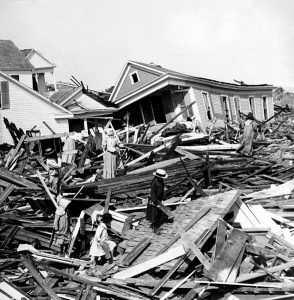
Wreckage from the Great Galveston Hurricane in 1900
Summary
On September 8, 1900, Galveston, Texas, was struck by a category 4 hurricane that decimated the island and killed thousands of people, making it the deadliest natural disaster in U.S. history.
Great Galveston Hurricane
The day before the hurricane struck, heavy swells were noticed in the Gulf, and by the early morning of the 8th, coastal areas of Galveston had begun to flood. Rain showers started later that morning, with heavy rains beginning by noon. By 3:30 p.m. water covered half the city, and it continued to steadily rise until about 8:30 p.m. In total, the storm surge rose about 15-20 feet, completely submerging the island (which sat just 9 feet above sea level).
In addition to the flood of water, hurricane-velocity winds started around 5 p.m., topping out at an estimated 140 miles per hour and turning debris into deadly projectiles. The storm center passed over around 8:30 p.m., and finally, around 11 p.m., the wind began to subside.
Deaths and Damage
The next morning, survivors discovered the hurricane had left mass devastation in its wake. The lowest estimate of those killed is 6,000, though estimates of 8,000 or 12,000 are also common. More than 3,600 houses (about half of the residence portion of the island) were totally destroyed, with all remaining structures suffering varying levels of damage.
Aftermath
The vast number of dead, combined with the heat and humidity, quickly created a horrible stench across the island. Residents originally tried to bury many of the dead at sea, but when the tide washed the bodies back to shore, they began to burn the bodies instead.
A nationwide relief effort was launched to help Galveston’s devastated population, and in the months and years following the hurricane, Galveston rebuilt.
Learn more about 1900 Galveston Hurricane through historical newspapers from our archives. Explore newspaper articles, headlines, images, and other primary sources below.
Articles and Clippings about 1900 Galveston Hurricane
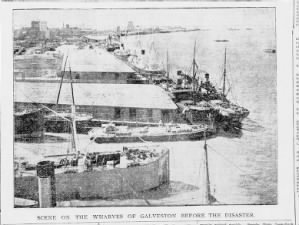 Photo of the wharves of Galveston before the 1900 hurricane Tue, Sep 11, 1900 – Page 3 · New-York Tribune (New York, New York, New York, United States of America) · Newspapers.com
Photo of the wharves of Galveston before the 1900 hurricane Tue, Sep 11, 1900 – Page 3 · New-York Tribune (New York, New York, New York, United States of America) · Newspapers.com Newspaper reports that a hurricane is nearing Galveston, Texas, in September 1900 Sun, Sep 9, 1900 – Page 1 · The Eagle (Bryan, Brazos, Texas, United States of America) · Newspapers.com
Newspaper reports that a hurricane is nearing Galveston, Texas, in September 1900 Sun, Sep 9, 1900 – Page 1 · The Eagle (Bryan, Brazos, Texas, United States of America) · Newspapers.com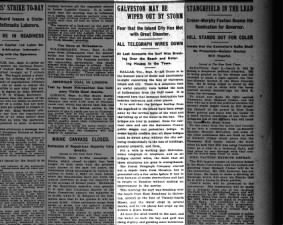 Galveston feared "wiped out by storm"; telegraph lines and bridges to the island are destroyed Sun, Sep 9, 1900 – Page 1 · The New York Times (New York, New York, New York, United States of America) · Newspapers.com
Galveston feared "wiped out by storm"; telegraph lines and bridges to the island are destroyed Sun, Sep 9, 1900 – Page 1 · The New York Times (New York, New York, New York, United States of America) · Newspapers.com Texas newspaper front page headlines about the hurricane that destroyed Galveston in 1900 Mon, Sep 10, 1900 – Page 1 · El Paso Herald (El Paso, El Paso, Texas, United States of America) · Newspapers.com
Texas newspaper front page headlines about the hurricane that destroyed Galveston in 1900 Mon, Sep 10, 1900 – Page 1 · El Paso Herald (El Paso, El Paso, Texas, United States of America) · Newspapers.com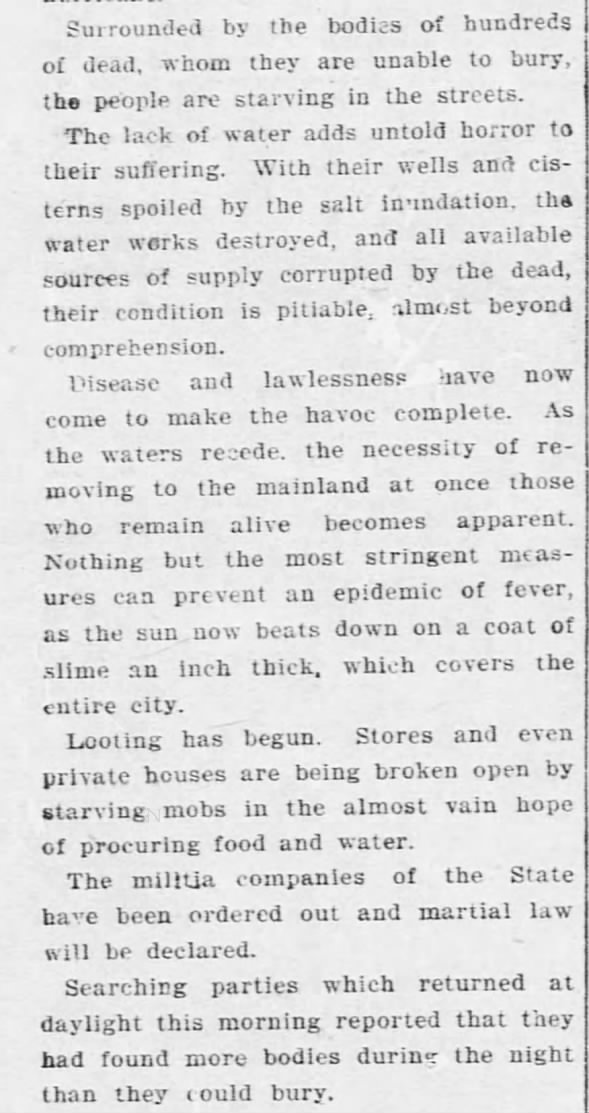 Description of the situation in Galveston in the days following the 1900 hurricane Tue, Sep 11, 1900 – Page 1 · The Evening Times (Washington, District of Columbia, United States of America) · Newspapers.com
Description of the situation in Galveston in the days following the 1900 hurricane Tue, Sep 11, 1900 – Page 1 · The Evening Times (Washington, District of Columbia, United States of America) · Newspapers.com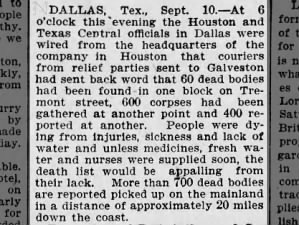 Multitudes of dead bodies are found in Galveston following the 1900 hurricane Tue, Sep 11, 1900 – Page 1 · The Scranton Republican (Scranton, Lackawanna, Pennsylvania) · Newspapers.com
Multitudes of dead bodies are found in Galveston following the 1900 hurricane Tue, Sep 11, 1900 – Page 1 · The Scranton Republican (Scranton, Lackawanna, Pennsylvania) · Newspapers.com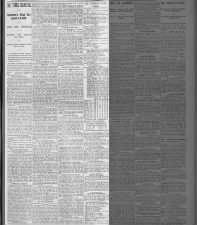 5,000 estimated dead from Galveston Hurricane and other facts as reported 4 days after the storm Wed, Sep 12, 1900 – 1 · Hartford Courant (Hartford, Hartford, Connecticut, United States of America) · Newspapers.com
5,000 estimated dead from Galveston Hurricane and other facts as reported 4 days after the storm Wed, Sep 12, 1900 – 1 · Hartford Courant (Hartford, Hartford, Connecticut, United States of America) · Newspapers.com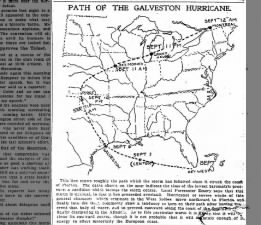 Illustration of the path of the 1900 Galveston Hurricane in the United States Wed, Sep 12, 1900 – Page 1 · The Brooklyn Daily Eagle (Brooklyn, Kings, New York) · Newspapers.com
Illustration of the path of the 1900 Galveston Hurricane in the United States Wed, Sep 12, 1900 – Page 1 · The Brooklyn Daily Eagle (Brooklyn, Kings, New York) · Newspapers.com Missouri family caught in the Galveston Hurricane is survived only by son Thu, Sep 13, 1900 – Page 8 · The St Louis Republic (St. Louis, St. Louis, Missouri) · Newspapers.com
Missouri family caught in the Galveston Hurricane is survived only by son Thu, Sep 13, 1900 – Page 8 · The St Louis Republic (St. Louis, St. Louis, Missouri) · Newspapers.com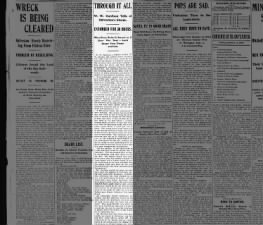 W. W. Garrison tells his story about being caught in the Great Galveston Hurricane Fri, Sep 14, 1900 – Page 1 · The Topeka Daily Capital (Topeka, Shawnee, Kansas, United States of America) · Newspapers.com
W. W. Garrison tells his story about being caught in the Great Galveston Hurricane Fri, Sep 14, 1900 – Page 1 · The Topeka Daily Capital (Topeka, Shawnee, Kansas, United States of America) · Newspapers.com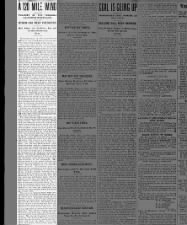 Account of the weather bureau reports forecasting the 1900 Galveston Hurricane Fri, Sep 14, 1900 – 4 · The Butte Daily Post (Butte, Silver Bow, Montana, United States of America) · Newspapers.com
Account of the weather bureau reports forecasting the 1900 Galveston Hurricane Fri, Sep 14, 1900 – 4 · The Butte Daily Post (Butte, Silver Bow, Montana, United States of America) · Newspapers.com Railway officials report on the damage to railroads in Galveston after 1900 hurricane Fri, Sep 14, 1900 – Page 1 · The Wichita Daily Eagle (Wichita, Sedgwick, Kansas) · Newspapers.com
Railway officials report on the damage to railroads in Galveston after 1900 hurricane Fri, Sep 14, 1900 – Page 1 · The Wichita Daily Eagle (Wichita, Sedgwick, Kansas) · Newspapers.com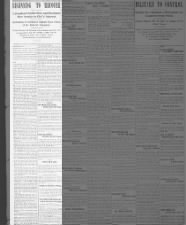 Article reports that Galveston, Texas, is starting to recover after hurricane in 1900 Fri, Sep 14, 1900 – Page 1 · The Leavenworth Times (Leavenworth, Leavenworth, Kansas, United States of America) · Newspapers.com
Article reports that Galveston, Texas, is starting to recover after hurricane in 1900 Fri, Sep 14, 1900 – Page 1 · The Leavenworth Times (Leavenworth, Leavenworth, Kansas, United States of America) · Newspapers.com Editorial against the rebuilding of Galveston after the 1900 hurricane Fri, Sep 14, 1900 – Page 4 · Washington Times (Washington, District of Columbia) · Newspapers.com
Editorial against the rebuilding of Galveston after the 1900 hurricane Fri, Sep 14, 1900 – Page 4 · Washington Times (Washington, District of Columbia) · Newspapers.com Excerpt from a list of Galveston dead following the 1900 hurricane Mon, Sep 17, 1900 – Page 3 · The St Louis Republic (St. Louis, St. Louis, Missouri) · Newspapers.com
Excerpt from a list of Galveston dead following the 1900 hurricane Mon, Sep 17, 1900 – Page 3 · The St Louis Republic (St. Louis, St. Louis, Missouri) · Newspapers.com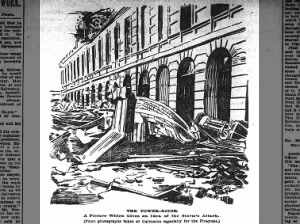 Picture based on a photo gives idea of the damage caused by the Great Galveston Hurricane Tue, Sep 18, 1900 – Page 7 · The Times-Picayune (New Orleans, Orleans, Louisiana) · Newspapers.com
Picture based on a photo gives idea of the damage caused by the Great Galveston Hurricane Tue, Sep 18, 1900 – Page 7 · The Times-Picayune (New Orleans, Orleans, Louisiana) · Newspapers.com Reverend O.P. Cook discusses what he sees as the lessons learned from the Galveston Hurricane Thu, Sep 20, 1900 – Page 9 · The Ottawa Herald (Ottawa, Franklin, Kansas, United States of America) · Newspapers.com
Reverend O.P. Cook discusses what he sees as the lessons learned from the Galveston Hurricane Thu, Sep 20, 1900 – Page 9 · The Ottawa Herald (Ottawa, Franklin, Kansas, United States of America) · Newspapers.com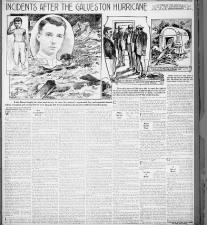 Journalist shares incidents and experiences that followed the 1900 Galveston Hurricane Sun, Sep 30, 1900 – Page 41 · St. Louis Post-Dispatch (St. Louis, St. Louis, Missouri, United States of America) · Newspapers.com
Journalist shares incidents and experiences that followed the 1900 Galveston Hurricane Sun, Sep 30, 1900 – Page 41 · St. Louis Post-Dispatch (St. Louis, St. Louis, Missouri, United States of America) · Newspapers.com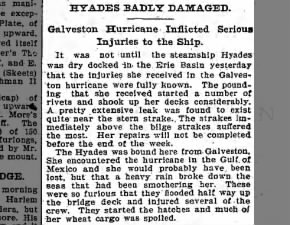 Galveston Hurricane causes serious damage to steamship Hyades in the Gulf of Mexico Tue, Oct 2, 1900 – Page 1 · The Brooklyn Daily Eagle (Brooklyn, Kings, New York) · Newspapers.com
Galveston Hurricane causes serious damage to steamship Hyades in the Gulf of Mexico Tue, Oct 2, 1900 – Page 1 · The Brooklyn Daily Eagle (Brooklyn, Kings, New York) · Newspapers.com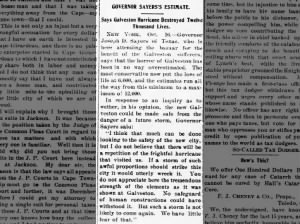 Governor of Texas, Joseph D. Sayers, puts loss of lives in the Galveston Hurricane at 6,000-12,000 Sat, Oct 20, 1900 – Page 1 · The Cape Girardeau Democrat (Cape Girardeau, Cape Girardeau, Missouri) · Newspapers.com
Governor of Texas, Joseph D. Sayers, puts loss of lives in the Galveston Hurricane at 6,000-12,000 Sat, Oct 20, 1900 – Page 1 · The Cape Girardeau Democrat (Cape Girardeau, Cape Girardeau, Missouri) · Newspapers.com